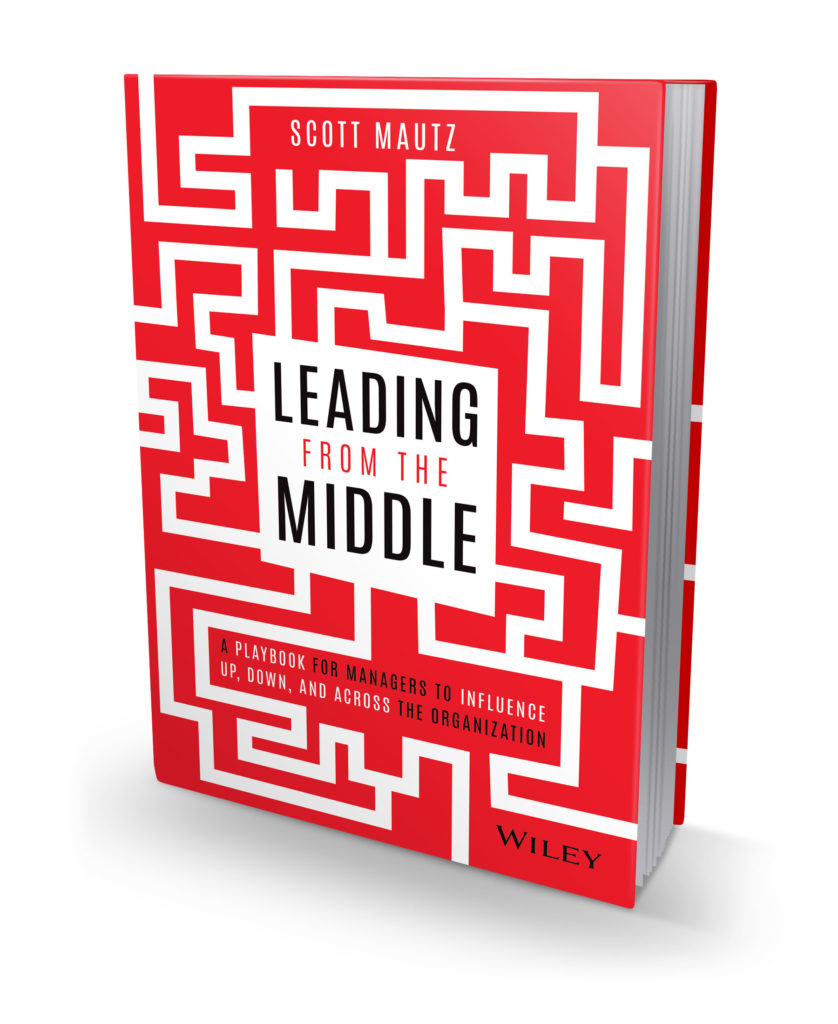
If you’re reading this, odds are, you’re a middle manager, i.e. someone who has a boss and is a boss, who has to lead and influence from the messy middle, up, down, and across their organization. Take pride and take heart because I’m going to help with the toughest job in any company, that of a person who must influence in all directions to do his/her job well.
I interviewed over 3,000 successful middle managers for my new book, Leading from the Middle: A Playbook for Managers to Lead Up, Down, and Across the Organization. The most common theme I heard for why the job of middle manager is so darn difficult could be summed up in one word. Scope. How all-encompassing the job is, all the hats you’re forced to wear. The word “scope” also plays out as a handy acronym (SCOPE) that spells out the 5 most common challenges middle managers face given the breadth and depth of their role:
Self-Identity. As a middle manager, all the hats you must wear forces you to constantly make what psychologists call “micro-transitions” throughout the day. One moment you’re in a deferential stance with your boss, the next moment you’re in assertive mode with direct reports, then collaborative mode with peers, sometimes all within the same meeting! You constantly switch from high-power roles to low power roles, having to jump into roles at times that you weren’t mentally prepared to play. Research shows the constant switching exhausts us to the point of detriment and leaves us wondering what our role really is.
Conflict. Middle managers also face challenges of conflict from the natural tensions and pressure from all sides. Your boss hassles you, your employees resist, your peers won’t collaborate. You absorb discontent from all around. You deal with conflicting agendas, conflicts of interest, and interpersonal conflicts.
Omnipotence. With the omnipotence challenge, you feel like you’re expected to know everything. Those in the C-Suite aren’t expected to know everything, because that’s what they have you for. Newer hires aren’t expected to know everything, they’re too new. But you, in the middle? It’s a different story. Your market share ticked down in Peoria, you better know why!
Physical. For middle managers, there’s also a physical challenge, born from the disproportionate amount of stress and anxiety you feel, especially from, you guessed it, the constant micro-switching.
Emotional. Finally, there are unique emotional challenges as well. You might feel a sense of alienation, isolation, and loneliness, as being in the middle makes it hard to really be a part of anyone’s group.
So what’s the solve for all of this? Well, in the book Leading from the Middle, I get into a very specific playbook, so in the spirit of that, I’ll share a few specific tips here.
Throughout the years of research I’ve been conducting on leaders in the middle, across the thousands of interviews and data points I’ve collected, something very important has surfaced. Time and again I’ve seen an interesting pattern–the most successful “middle managers” accept the complex reality of their role and all its unique difficulties, but at the same time, to keep it all in perspective, they’re constantly mentally reframing their role of leading from the middle in inspirational ways. I’ll share just a few of the most powerful reframes I’ve heard.
The micro-transitions you’re constantly making aren’t segmented, they’re integrated.
The 100 jobs you belong to add up to one vital job you’re uniquely suited to do well. Take pride in that and value the variety.
You’re the keeper of the long and short-term flame, working ON the business and IN the business.
This is a unique privilege that only those who must lead up to a boss, down to their direct reports, and across to their teams and peers, get to experience.
You’re a lighthouse and a beacon, signaling threats and drawing all towards opportunities.
It’s in the nature of the many hats you must wear. Your energy effects so many others in so many ways.
The best middle managers think like an engineer, feel like an artist.
The job is to think with great discipline, strategy, and structure, but to feel with empathy and high-EQ. Leading from the middle requires skill at achieving the balance.
In my research and from my experience, I also have much to share about how to specifically lead and influence in all directions—up, down, and across. Here’s one power-tip for each.
Leading and influencing UP – Understand the asks:
Being able to lead and influence your chain of command starts with being crystal clear on what’s expected of you and what it takes to overdeliver in his/her eyes. I conducted research with hundreds of boss subordinate pairs for Leading from the Middle and found there were material breaches in understanding of expectations a whopping 80% of the time! So, know what good performance looks like, and what great performance looks like, according to your boss’s definition. Literally sit down with him or her and write out definitions of what good versus great looks like on metrics of performance that matter most for you, like leadership, priority-setting, or taking initiative, for example.
Leading and influencing DOWN – Master the fundamentals of giving great feedback:
Giving high quality feedback is the most essential role for managers of others. Remember the rules of giving great feedback: be specific (otherwise it won’t stick), sincere (if it comes from the heart it sticks in the mind), timely (after the fact feedback is matter of fact feedback), tailored (find out how the recipient likes to receive feedback), proportionate (5 pieces of reaffirming feedback for every 1 piece of corrective feedback), and put the feedback in context (“this feedback means you’re off track” or “this means you’re right where you should be at this stage of your development.”)
Influencing ACROSS – Leverage the Golden Rule of Influence:
How do you influence those over whom you have no formal authority? In my research, I came across something author Dan Schwartz shared that really summed up the key to this—something that I’ve come to call the “Golden Rule of Influence.” Think of people in your life who had no authority over you, yet who were tremendously influential. What did they do to influence you? Odds are, it was one of four things. When it came to you, they would care, listen, give, and teach. That’s it. The Golden Rule of Influence says influence others the same basic ways you were influenced. It’s especially powerful for influencing peers you have no authority over because your willingness to care, listen, give, and teach outside your scope of direct responsibility aren’t the norm and will be seen as true gifts. The absence of authority isn’t a barrier to influencing because you’re drawing on the basics of human emotion and empathy.
So, don’t feel like you’re stuck in the middle. Instead, know you have the chance to lead in every direction.
Get my new book, an Amazon #1 BEST-SELLER in multiple categories! Leading from the Middle: A Playbook for Managers to Influence Up, Down, and Across the Organization can be ordered here https://amzn.to/3as5tK8 OR… Get a massive BONUS BUNDLE by ordering copies for your team (5 or more) here: http://lftm.bulkbooks.com/ Check out a detailed book description here: https://bit.ly/2MLe5Do





Leave a Reply